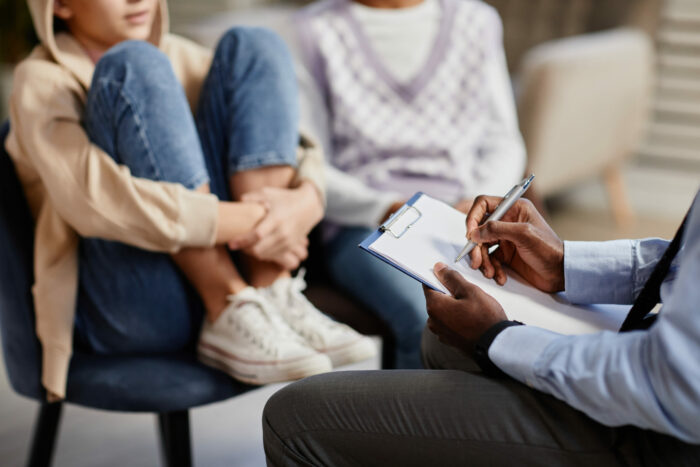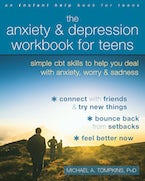By Michael A. Tompkins, PhD, ABPP, author of The Anxiety and Depression Workbook for Teens
Whether you call them therapeutic homework, action plans, or exercises, these out-of-session activities can help teens in several ways:
- Action plans help teens repeatedly practice skills in order to build confidence in their ability to apply the skill when needed. Teens understand that they won’t master a skill (doing math problems, skateboarding, playing the piano) if they don’t practice it repeatedly. Creating action plans is the way to do this.
- Action plans help generalize new learning—including newly learned skills—to real-life situations. For example, it’s one thing to learn and apply assertiveness skills in the therapist’s office, and quite another to apply these skills in the classroom or at home. Teens who are confident that they can apply a skill in their day-to-day lives are more likely to apply the skill and benefit from it.
- Action plans help teens practice skills in the presence of negative emotions, such as anxiety, depression, guilt, or anger. Many teens tend to avoid negative feelings along with any task that triggers these feelings. For example, teens might avoid their anxious feelings by avoiding saying hello to teens that they don’t know well, or avoid their depressed feelings by withdrawing rather than hanging out with a friend.
Present Rationale for Action Plan Tied to Treatment Goals
Teens tend to follow through with action plans when they understand how the action plan will help them reach one or more of their therapy goals. For example, if you’re suggesting a depressed teen try pleasant activities, begin by explaining how increasing pleasant activities can help them feel less depressed over time:
Depression causes people to feel less interested in doing fun, interesting things, and giving into this tendency strengthens the depression. Therefore, the first step toward feeling less depressed is to do a little more, even when that feels hard to do. How about if we come up with a plan to do that?
Adjust Action Plan Relative to Confidence Level
The best action plan is an action plan that teens try. Therefore, it’s important to take a few moments to adjust any action plan relative to how confident the teen is that they can and will do it. An easy way to do this is to set up an action plan and ask the teen how confident—on a 0 to 100 percent scale (where 100 percent is guaranteed to do it)—they are that they will try the action plan as you and the teen have set it up. Strive for 90 percent confidence level or higher. If the teen rates confidence less than 90 percent, modify or breakdown the action plan until the teen is reporting 90 percent or higher confidence level.
Present Action Plan as an Experiment
Present action plans as an experiment. The idea of an experiment can harness the curiosity of teens. Also, presenting action plans as experiments takes pressure off teens who may fear they’ll fail to do it correctly. The results of experiments are neither good nor bad, right nor wrong. Even when an experiment doesn’t turn out the way you and the teen expected or wanted, it’s not a failed experiment. You and the teen learned something from the experiment that will help with the next one:
Remember, an action plan is like an experiment and there’s no such thing as a failed experiment or a failed experimenter. Regardless of how much the action plan helps or doesn’t help, we’ll learn something useful and we’ll use that when we come up with the next action plan.
Practice Action Plan in Session
After you’ve created an action plan with the teen and the teen is confident that they’ll try it, ask the teen to close their eyes and rehearse in their mind first. Rehearsing the action plan in this way builds the teen’s confidence that they know how to do it, and can help troubleshoot problems that might arise when the teen tries it. For example, if the action plan is for the teen to call the therapist for phone coaching, during the mental rehearsal the teen might discover they don’t have the therapist’s telephone number. Similarly, if the teen is anxious about calling the therapist, ask the teen to imagine the steps to call the therapist. With each mental rehearsal, ask the teen to rate their confidence (0 to 100 percent) that they can do the action plan and how anxious (in this case) they feel. Repeat this practice in session until the teen reports 90 percent or greater confidence.
Demonstrate Rationale of Action Plan in Session
This tip is perhaps the most important one. To increase the likelihood that the teen will try an action plan, demonstrate in the session that the action plan helps. For example, if you’re teaching a relaxation skill—such as diaphragmatic breathing for the teen to calm and relax their body—ask the teen to rate their level of stress or anxiety prior to practicing the skill, and then re-rate it after. If the rationale for this action plan is for the teen to be able to relax their body—and the teen reports they’re more relaxed—then you’ve shown the teen that it works. Similarly, if you and the teen have developed coping statements to help them feel less depressed, ask the teen to close their eyes, imagine a situation in which they might use the coping statement, and rate their level of depression before and after using the coping statement.
The best action plan in the world is useless if teens are not willing to try it. These tips can increase the willingness of teens to try new skills that you believe can help them feel and stay better. The trick is to create an action plan that teens will not only try, but will learn something in the process that sets them up to try the next.
Michael A. Tompkins, PhD, ABPP, is a board-certified psychologist in behavioral and cognitive psychology. He is codirector of the San Francisco Bay Area Center for Cognitive Therapy, and is a faculty member of the Beck Institute for Cognitive Behavior Therapy. Tompkins is author or coauthor of fifteen books, and presents to national and international audiences on cognitive behavioral therapy (CBT) and related topics. His work has been highlighted by media outlets, including in The New York Times, The Wall Street Journal; on television (The Learning Channel, A&E); and on radio (KQED, NPR).



 2024 Peace Playbook: 3 Tactics to Avoid Clashes with Your Partner
2024 Peace Playbook: 3 Tactics to Avoid Clashes with Your Partner